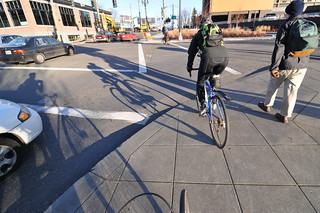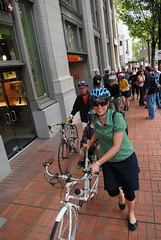People that bike, walk (or roll, in the case of wheelchair and electric scooter users) share sidewalks every day, and the combination of modes can cause conflict and confusion. Oregon law, however, is very clear on right-of-way and the legal conduct required when you are bicycling on the sidewalk.
Legal clarity aside, the devil is in the details.
One problem is that bicycle operators travel much faster than walkers and require considerably greater distance to turn and stop. When bicycle traffic is constricted, such as on bridges and other multi-use paths, the inevitable congestion magnifies the impact of the small steering or control mistakes that lead to occasional collisions.
Historically, many villages and cities have identified areas with the highest density of walkers and declared them off limits to bicycling. In Portland, bicycling on the sidewalk is prohibited in the area within SW Jefferson Street, Naito Parkway, NW Hoyt Street and 13th Avenue (except in the Park Blocks, on bridges and multi-use paths). However there are no warning signs to define these boundaries, and (as a result) an almost universal ignorance and disregard of the law. This creates an uncertain environment for everyone that guarantees selective and uneven enforcement.
While New York City prohibits biking on sidewalks for people over 14 years of age, a more recent law includes a “pedestrian-endangerment” provision carrying a $300.00 fine or 20 days in jail and bike impoundment. Physical contact with someone walking on the sidewalk results in a $600.00 fine or 20 days imprisonment and bike impoundment. While protecting people is a laudable goal, in an average year in New York City (2011 population 8.2 million), bicycling on sidewalks resulted in zero deaths and fewer than 200 injuries to people walking. In the same average year motor vehicle operators kill 200 walkers and injure 11,000 of them. Clearly, the safety hazard associated with bicycling on sidewalks is more of an annoyance than a high-level, life-threatening risk, at least when compared to other hazards.
The law is clear
The law is clear that people who are walking have the right of way on sidewalks and people on bikes must provide an audible signal when they pass. To obtain the same right-of-way privileges while on your bike (with respect to motor vehicle operators) as you get while walking, you are limited by the Oregon Vehicle Code to “no greater than a walking speed” — but that mandate only applies when entering driveways or entryways and on crosswalks where there is oncoming motor vehicle traffic. And of course, walkers also have the right-of-way over any other road user when they are in marked or unmarked crosswalks and on sidewalks.
One problem area is that people riding bikes on the roadway sometimes fail to yield to sidewalk users attempting to cross the in marked and unmarked crosswalks. ORS 811.020 prohibits passing another vehicle who has stopped to allow someone to cross, but bicycle operators frequently disregard this provision (to the consternation of other road users). Further, bicycle riders sometimes act as if they believe they are on a higher moral plane than other vehicle users and therefore do not really have to stop for people in crosswalks. Other riders demonstrate their trick riding skills by weaving around clusters of alarmed walkers. The Oregon Vehicle Code prohibits such behavior. ORS 814.410, “Unsafe Operation of Bicycle On Sidewalk,” is violated if a person “[O]perates a bicycle on a sidewalk in a careless manner that endangers or would be likely to endanger any person or property,” creating an offense with similar operational language to the better known “Careless Driving offense”.
In conclusion, when the rules are followed, sidewalk bicycle riding can be safe. However, riders sometimes save their worst behavior for the sidewalks and ignore the laws that regulate their use. When people are aware of the laws — and more important when the follow them — the whole mix goes a lot more smoothly and the sidewalk can provide an important artery for non-motorized travel.
(Note: This guest post was edited to reflect our editorial guidelines.)

(Photo © J. Maus/BikePortland)
This article is part of our monthly legal series with Portland-based lawyer and bike law expert Ray Thomas of Swanson, Thomas, Coon & Newton. (Disclaimer: STC&N is a BikePortland advertiser and this monthly article is part of our promotional partnership.)



